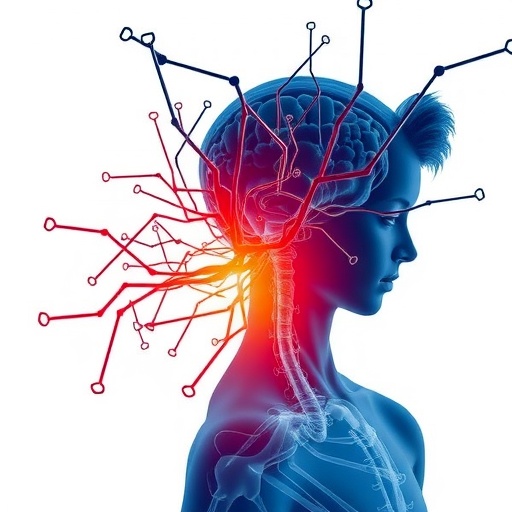Emerging research has increasingly highlighted the complexities of pain perception among adolescents, unveiling intriguing sex differences that bear significant implications for understanding pediatric health. In the realm of pain management and treatment, the acknowledgment and exploration of these differences are fundamental to developing effective intervention strategies. A recent study authored by Hagy, Hidalgo-Lopez, Portengen, and colleagues has offered a conceptual framework aimed at understanding these dynamics, specifically focusing on the biopsychosocial model.
The biopsychosocial model serves as a holistic lens through which to examine the multifaceted nature of pain and its experiences, particularly in the transformative period of adolescence. This model posits that biological, psychological, and social factors interplay to influence how individuals perceive and respond to pain. Although traditionally viewed as a uniform experience, research reveals that pain can manifest differently across genders, suggesting that distinct variables shape pain responses in boys and girls. This underscores the need for a tailored understanding of pain, as it could drastically inform clinical practices.
One of the most striking discoveries in the study is the notion that sex differences in pain perception emerge distinctly during adolescence. Prior to this developmental stage, boys and girls exhibit similar pain sensitivity levels; however, with the onset of puberty, disparities become pronounced. This period of rapid physiological and hormonal changes may produce varied pain experience and expression across genders. Understanding the timing and triggers for these differences is essential for healthcare providers aiming to address pediatric pain effectively.
The authors of the study emphasize that biological factors, such as hormonal fluctuations, can substantially influence the threshold and expressions of pain in adolescents. For instance, the increase in estrogen and testosterone levels during puberty has been linked to altered pain sensitivity and associated behaviors. This biological foundation is critical; however, the research goes one step further by integrating psychological and social components into the discussion, which are equally pivotal in understanding adolescent pain.
Psychological factors, including mental health conditions such as anxiety and depression, can exacerbate pain experiences among adolescents. Notably, girls are statistically more likely to report higher levels of anxiety and depression during adolescence than boys, potentially leading to increased pain sensitivity. Conversely, societal norms and expectations related to gender may also dictate how pain is perceived and reported, further complicating the clinical picture. Understanding these psychological aspects is vital for developing comprehensive pain management strategies.
Social influences play a crucial role in shaping adolescent pain experiences. Gender stereotypes often dictate how pain is communicated and validated; for instance, boys might be socialized to exhibit stoicism in the face of pain, while girls might be encouraged to express their discomfort more openly. These divergent social conditioning practices can significantly impact how adolescents report and cope with pain, thereby affecting overarching treatment practices.
Furthermore, the study posits that individual differences, including genetic predispositions and past pain experiences, shape one’s pain profile. These factors reinforce the message that pain cannot be understood in isolation. Each adolescent’s experience is distinct, and recognizing this individuality is central to tailoring interventions that consider these various dimensions.
The authors recommend that future research should focus on longitudinal studies to further explore the evolving nature of pain and its determinants over time. Investigating how pain develops and changes throughout adolescence can yield valuable insights that will inform better health practices. Long-term studies could similarly illuminate the long-lasting effects of adolescent pain experiences, potentially revealing how they influence adult pain behaviors.
Interventions designed for this age group should thus take into account both the biological and psychosocial aspects of pain. A biopsychosocial framework allows clinicians to adopt integrative approaches, ensuring that treatment encompasses physical symptoms alongside emotional and social contexts. This perspective fosters comprehensive assessments and therapeutic strategies that can empower adolescents to manage their pain more effectively.
In light of these findings, the healthcare community must prioritize education and training around sex differences in pain. Clinicians should be equipped with tools that enable them to recognize and respond to these distinctions appropriately. Creating an environment that encourages open conversations about pain can also mitigate the stigma attached to emotional expressions of discomfort, facilitating better reporting and management of pain.
As research continues to evolve, the integration of findings into clinical practice will be crucial for ensuring that adolescents receive holistic care. By recognizing and addressing the unique pain profiles of boys and girls during adolescence, we can make significant strides towards improved health outcomes. This understanding paves the way for personalized pain management approaches that reflect an appreciation of the developmental, psychological, and social complexities inherent in each young individual’s journey.
In conclusion, the landscape of adolescent pain is multifaceted and influenced by a myriad of intersecting factors. Understanding these intricacies through the lens of a biopsychosocial model offers promising avenues for future research and clinical application. As the discourse surrounding sex differences in pain deepens, it is essential to remain vigilant about the evolving nature of pain experiences and their implications for health parity among adolescents.
Subject of Research: The emergence of sex differences in primary pain during adolescence.
Article Title: The emergence of sex differences in primary pain during adolescence: a conceptual developmentally-oriented biopsychosocial model and opportunities for further investigation.
Article References:
Hagy, H., Hidalgo-Lopez, E., Portengen, C. et al. The emergence of sex differences in primary pain during adolescence: a conceptual developmentally-oriented biopsychosocial model and opportunities for further investigation.
BMC Pediatr 25, 899 (2025). https://doi.org/10.1186/s12887-025-06283-3
Image Credits: AI Generated
DOI: https://doi.org/10.1186/s12887-025-06283-3
Keywords: Adolescence, Pain perception, Sex differences, Biopsychosocial model, Healthcare implementation, Psychological factors, Social influences, Gender stereotypes, Longitudinal studies, Personalized interventions.




